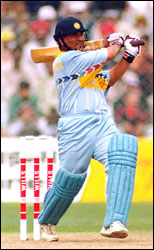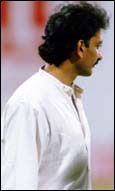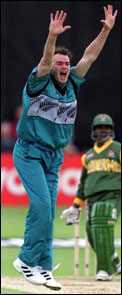The Lost Decade
Jai Natarajan
For fans of Indian Test cricket, the nineties were a time of
puzzling schizophrenia. While India proved extremely strong at
home, beating everyone from Australia to Sri Lanka, they
created one remarkable statistic -- no Test victories outside
the subcontinent. In fact, during the whole decade, they won just
a single away Test versus Sri Lanka.
Take a deep breath and consider this again: ten years and not
one Test win. Even the worst teams in the world (we could argue that
this statistic makes us one of the worst) managed to win something
abroad. We failed to beat even England and the West Indies during
their period of decline. Mind you, we didn't draw any of these series
either. We lost all of them, even to New Zealand and Zimbabwe.
 Was India a struggling side of untalented fringe players ? No!
Most puzzling: the individual careers of the core members of the
side soared. The nineties was the decade of Tendulkar. Individually,
he strode like a colossus. Anil Kumble, Srinath, Azharuddin, Sidhu -- they all did well, statistically. Ganguly and Dravid came into the side in 1996 and became superstars.
Was India a struggling side of untalented fringe players ? No!
Most puzzling: the individual careers of the core members of the
side soared. The nineties was the decade of Tendulkar. Individually,
he strode like a colossus. Anil Kumble, Srinath, Azharuddin, Sidhu -- they all did well, statistically. Ganguly and Dravid came into the side in 1996 and became superstars.
How does one reconcile this array of talent with the devastating results outside India? How did the whole become less than the sum of the parts ?
Many factors can be hotly argued. Domestic conditions, selection policies,
technique, temperament, lopsided schedules, etc. How do you explain year
after year of utter mind-numbing defeat? More importantly, what do you change
for future success?
As a starting point, consider this unholy dozen. Described here are
six Tests from this decade -- all outside the subcontinent. In a
positive spirit, these six matches are in fact matches that India
could, or should, have won. They held the ascendancy time and again and let
it slip. Perhaps we can learn vital lessons from recalling these games.
After all, for long sessions in these games we did everything right,
and sometimes brilliantly, but we fell short in the end. And the bottom
line stares at us, accusing us of rank failure of a whole generation
of prime sportsmen at their peak playing for a cricket mad country
in a sport flush with cash like never before.
Here they are :
1. India v/s England, T3, The Oval, Aug. 1990
India came into this Test 1-0 down after two high scoring
Tests. Big knocks by Shastri and Kapil (187, 110) punctuated
by a typically career-reviving 78 by Azhar and a characteristically
cheeky 61 by Kiran More meant India had its highest total of the
series -- 606-9.
In reply, Gooch held the England innings together with 85.
At one point India had England on 233-7 but Eddie Hemmings,
hitherto unheralded with the bat, came up with 51 at No 9 to frustrate
us. On the follow-on, England simply shut India out, Gooch getting
the last word, grinding the attack in and consuming the clock.
Only Prabhakar ever looked dangerous -- Kapil, Wasson, Hirwani
and Shastri making up the rest of the lame-duck attack which
never saw the end of Gooch in this series.
2. India v/s Australia, T3, Sydney, Jan 1992
Amazingly (and this is a pattern), India played no more away Tests
in 1991 until Nov 29 when they kicked off their Australian tour.
They came to Sydney on January 2, 2-0 down and very much outplayed,
their batting in tatters. For reasons best known to themselves, India went
into the Sydney Test with just half a spinner (Shastri) and
four seamers including young Srinath. As Raju cooled his heels
in the pavilion on Australia's most spin-friendly pitch,
Subrota Bannerjee, impressive on debut, helped Kapil and Prabhakar
pin Australia to 313 (their third 300-plus first innings total) despite David
Boon's century.
 The Indian batting finally got it together around the stoic Ravi Shastri's 206, aided by Tendulkar's 148.
The Indian batting finally got it together around the stoic Ravi Shastri's 206, aided by Tendulkar's 148.
With a lead of 170 Shastri made inroads into the Aussie top order to have
Australia at 114-6 but Border with 53* fought off defeat with an
unlukely 21 from Merv Hughes. The selectorial folly was underlined
when Tendulkar's unique brand of spin broke the partnership in his
first over, too late to prevent the draw. India then slumped
to defeat in the next two Tests as well despite an 80 run lead in
the fourth test. Rarely had such a strong Indian side, mixing
youth and experience, boasting batting depth and seam strength,
underachieved so blatantly. The words "on paper" were forever
attached to the words "strong team" in the Indian context.
3. India v/s England, T2 Lord's, June 1996
Not till 1996 did India venture out of the subcontinent again,
barring a single drawn Test in March 1994 in Hamilton against New
Zealand. In between they had a string of succesful home series and
an away win in Colombo. Little did they they anticipate what a statistical
blip this away win would be for the 1990's. They were promptly back to
old habits, the batting failing twice at Birmingham against the barely
savage attack of Chris Lewis, Dominic Cork and Alan Mullaly. Tendulkar
alone stood among the ruins with 122 but this was countered by Nasser
Hussain's 128. Srinath and Prasad started their new ball pairing in
defeat despite 4 wickets each in the first innings.
Injuries before T2 changed the face of Indian cricket for the rest of
the decade (without changing its away scorecard) as Sourav Ganguly
and Rahul Dravid entered the fray at Lord's. India's typical generosity
to tailenders enabled England to recover from 107-5 to 344,
with Thorpe making 89, Russell 124 and Lewis 31. The passenger
on this tour was Paras Mhambrey while Prasad picked up his first five-fer
and actually looked like a solution to India's new ball attack.
New boys Ganguly and Dravid opened the door to victory with 131 and
95, as India went 85 ahead. Alas they failed to press the advantage
as England ground out 278-9 off 121 overs, fighting all the way down
the order (Irani 41, Russell 38, Lewis 26, Peter Martin 23 at No 10).
A high scoring draw in T3 extended the drought as one of the weakest teams
in international cricket took a 1-0 series win against us. Lewis,
Irani and Martin went back into oblivion soon after, like many fringe
players who seem to appear on the scene only to thwart India at some
critical moment.
4. India v/s SA, T3, Johannesburg, Jan 1997
Complete Indian batting failure in the first Test and bowling failure
in the second Test sent India into this match with the series already lost.
With makeshift openers and minimal support for the persevering Srinath and
Prasad, India seemed in the throes of a wipeout by an efficient South African
unit, held together by the allrounders Brian McMillan and Lance Klusener.
With nothing but pride to play for, the Indians finally got some runs
on the board (410) thanks to an epic 148 but Rahul Dravid, a knock of
smouldering intensity and concentration. Only Ganguly, finally coming good
in the middle order with 73, crossed 50. South Africa's brittle lineup
was sliced in half by Srinath, being at one stage 147-5.
But as usual, the
allrounders provided backbone as SA recovered to 321, Pollock making 79.
In reply, India sensed a chance when the openers Rathore and Mongia finally
got a stand of 90 together. Dravid continued where he left off with a steel
81 and Ganguly provided the charge as India declared att 266-8 off 83 overs.
It was a rather good comeback from the utterly hapless performances of the
first two games.
The game was all about time, with SA having to survive some 68 overs. Kumble
found some form and Srinath and Prasad bowled well to reduce SA to 95-7. Even
as the excited Indians sensed the end of the drought, Klusener came in to
join Cullinan and put on 127 for the 8th wicket, getting out right at the end
of the vigil. The frustration for India appeared endless as Kumble could
not get past the blade of Cullinan who has struggled so much against Shane Warne
in his career. Dodda Ganesh, as third seamer, bowled a total of nine overs in the
the two innings. Lance Klusener had well and truly launched his career at the end
of the twin series against India.
5. India v/s West Indies, T3 Bridgetown, Mar 1997
The Indian batting straightaway looked more robust with the return of Sidhu.
But the selectors' cavalier attitude to the crucial openers spots continued
as they picked VVS Laxman to somehow magically transform his middle order
skills into an opener in the Caribbean of all places.
Another blow was the injury to Srinath which meant he missed the tour fast bowlers
dream about all their lives. Abey Kuruvilla, a steady and effective bowler who
would have made a great third seamer, found himself picked about five years too late
to spearhead the attack with Prasad.
WI bore a fairly scruffy look as well, on the decline barring the great pace duo and
occasional flashes form Lara and Chanderpaul.
Honors were even in the first two Tests, as Sachin Tendulkar marshalled his resources
and Lara, Hooper and Chanderpaul blunted the spin threat of Kumble and Joshi.
In the third test at Barbados, the docile swing attack of Prasad, Kuruvulla and
Ganesh had the WI in trouble at 193-7 before Ambrose stemmed the rot and allowed
Chanderpaul to guide WI to 298. India's response was mediocre as Tendulkar and
the consistent Dravid took India to a strong position before the tail gifted
it away. A 21-run lead was disappointing.
Complete sensation followed as the gentle giant Kuruvilla destroyed the WI
for 140 and all of a sudden India's target was merely 120. On a pitch
becoming more and more uneven, Lara took a firm hand in focussing Franklyn
Rose in a support role for Ambrose and Bishop. India made the mistake of being
too defensive. When a good cameo with a few risks might have won the day,
Sachin watched in horror as India collapsed to 81 all out, only Laxman spending
any time at the crease, being alone in the double figues.
With the next two matches crippled by rain, the series was lost. Most people would
point to this loss as being the most crushihng one personally for Tendulkar,
one that probably broke his back as captain and killed his appetite for the job.
6. India v/s New Zealand, T2 Wellington, Dec 1998
A splendid see-saw Test match in difficult conditions saw the balance swinging
several times. In the end India's old failings came to the fore and they
surrendered the Test (and the series). Azharuddin chose to bat only to see his
team destroyed on the first day by the left handed seamer Simon Doull. Only
a classic 103 by Azhar himself in conditions of prodigious seam and swing took
India to a barely satisfactory 208.
 By the end of the first day, New Zealand
had progressed to 52/1. Although conditions were easing quickly, Kumble made
inroads on day 2 and when Cairns got out at 179-6, India needed to press home
the advantage. The last specialist Astle was out at 208. Alas, yet again,
Srinath and Prasad failed to take out the tail. Utility men Nash and Vettori
played splendidly in a critical 8th wicket stand of 137 as New Zealand took
a 144 run lead. Dion Nash made 89* as Tendulkar finally mopped up the tail in
a few overs. India's openers Sidhu and Jadeja were gone by the 25th over, and
Dravid fell at 112 though the seamers were no getting as much out of the wicket.
India then fought down the order as Tendulkar forged stands with Ganguly
and Azhar, both of whom made 48. Kumble and Srinath took India to 356.
By the end of the first day, New Zealand
had progressed to 52/1. Although conditions were easing quickly, Kumble made
inroads on day 2 and when Cairns got out at 179-6, India needed to press home
the advantage. The last specialist Astle was out at 208. Alas, yet again,
Srinath and Prasad failed to take out the tail. Utility men Nash and Vettori
played splendidly in a critical 8th wicket stand of 137 as New Zealand took
a 144 run lead. Dion Nash made 89* as Tendulkar finally mopped up the tail in
a few overs. India's openers Sidhu and Jadeja were gone by the 25th over, and
Dravid fell at 112 though the seamers were no getting as much out of the wicket.
India then fought down the order as Tendulkar forged stands with Ganguly
and Azhar, both of whom made 48. Kumble and Srinath took India to 356.
Despite
this vastly improved performance, they had treated Nash and Doull with exaggerated
respect. Nash, in particular, had remarkable figures of 3-20 off 15 overs,
to join a long line of fringe players who reserved their best allround performances
for the Indian team.
The target of 213 was tantalising for both sides as Srinath took a wicket in the
very first over. However he tired rapidly and with Prasad bowling economically but
unthreateningly, Kumble was in the attack by the 10th over. He struck quickly
and Srinath's second spell and some good fielding reduced New Zealand to 74-5,
with Astle additionally retired hurt and unlikely to play again. McMillan and
Cairns then played aggressively, taking on Kumble who did the bulk of the bowling.
Azhar's curious reluctance to give much bowling to Harbhajan or Tendulkar
meant the batsmen settled and grew comfortable against the Karnataka trio.
Cairns, not for the last time, took the fight to India and his 61 brought
NZ to within four runs of victory. McMillan remained unbeaten with a critical
matchwinning knock in which he blustered his way past his inadquacies against
spin. A 4 wicket (really, 3 wicket) win for NZ set the seal on India's
frustration and heralded Cairns' coming of age as a batting mainstay for his team.
Ironically, both DOull and Nash were later forced out of international cricket
with injuries and remain out of the team at present.
What does the future hold ? Even today we see a recurrence of the themes. India
will not leave its shores for over a year since the Australia tour. By then,
all lessons will have been forgotten, continuity lost and the selection process
will once again get addled by months of one-day internationals and home games.
The core of the Test team remains unchanged. It is an interesting point whether
young talents like Zaheer and Yuvraj will survive the ODI merry-go-round long
enough to show their wares on our next tour. The third seamer and backup spin attack
remains an open question. Kumble and Srinath remain enigmas outside India. The
opening pair is not settled and will likely be makeshift. India's tour will
also be a mini-tour, offering little opportunity for an extended improvement curve
and few warmup games. One could take the view that India's best chance for a win
might come in the fifth Test of a second consecutive full away series with the same
basic squad team. But our short sighted board will never permit such a ghastly occurrence, as
the pressing claims of the one-day calendar seduce us away form the real thing.
A damning indictment of our calendars is the small number of Tests played
by Sachin and Dravid etc. in their careers when compared to Australians or
South African contemporaries.
If we do win a Test it will be from some act of individual brilliance, not from a
systematic evolution into a team which can be a force abroad on a consistent basis.
It wil certainly not be through the kind of long-term strategic thinking by which
South Africa just targeted and won their recent series against us on the subcontinent.
That perhaps is the most disappointing aspect of it all.
Mail Sports Editor